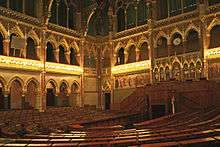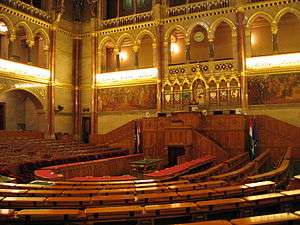Albert Apponyi
| Albert Apponyi | |
|---|---|
 | |
| Minister of Religion and Education of Hungary | |
|
In office 8 April 1906 – 17 January 1910 | |
| Preceded by | Gyula Tost |
| Succeeded by | Ferenc Székely |
|
In office 15 June 1917 – 8 May 1918 | |
| Preceded by | Béla Jankovich |
| Succeeded by | János Zichy |
| Personal details | |
| Born |
29 May 1846 Vienna, Austrian Empire |
| Died |
7 February 1933 (aged 86) Geneva, Switzerland |
| Political party | Deák Party, Liberal Party, National Party, Independence Party |
| Profession | politician |

Albert Apponyi de Nagyappony (29 May 1846 – 7 February 1933) was a Hungarian nobleman and politician.
Biography
He was born on 29 May 1846, in Vienna, where his father, Count György Apponyi, was the resident Hungarian Chancellor at the time. He belonged to from an ancient noble family dating back to the 13th century. Count Albert Apponyi became a member of the Hungarian Parliament in 1872 and remained a member of it, with one short exception, until 1918. From the late 1880s, he was the leader of the “united opposition,” which consisted of all parties hostile to the Austro-Hungarian Compromise of 1867.[1] He married Clotilde Apponyi in 1897.
He was Speaker of the House of Representatives of Hungary from 31 October 1901 to 6 November 1903.
As the minister of education he drafted the laws, sometimes called Apponyi laws, passed in 1907 in which the process of Magyarization culminated. Reading, writing and counting in primary schools was done exclusively in Hungarian for the first four years of education.[2] Approximately 600 Romanian villages were left without education as a result of the law. By 1917, 2,975 Romanian primary schools were closed.[3]
After World War I, Apponyi’s most notable public office was his appointment in 1920 to lead the Hungarian delegation to the Versailles Peace Conference to present Hungary’s case to the Allied and Associated Powers assembled there to determine the terms of the peace treaty with Hungary, which subsequently became known as the Treaty of Trianon on account of it having been signed in the Grand Hall of the Palace of Trianon. In the event, Apponyi’s mission to Versailles was in vain as the Allies refused to negotiate the terms of the peace treaty.
Between 1911–1932, he was five times nominated for the Nobel Peace Prize by Hungarian universities, scientists and political groups,[4] but never became a laureate. Count Apponyi was a noted orator and had wide ranging interests outside politics, encompassing linguistics (he was fluent in six languages), literature, philosophy and music. He visited the United States of America a number of times, first in 1904 and last in 1924, where he engaged in lecture tours and befriended leading public figures, including Presidents Theodore Roosevelt and William Howard Taft. Apponyi described his impressions of America in his autobiography The Memoirs of Count Apponyi, published by Heinemann (London), 1935. He was also the author of the book Esthetics and Politics, the Artist and the Statesman. He died on 7 February 1933, in Geneva, where he was waiting at the time to attend the re-opening of the League of Nations Disarmament Conference.
By the American and British media, he was often called as "The Grand Old Man of Central Europe". In Hungary he was named as "The Greatest Living Hungarian".
Works (selected)
- 1889: Parlamentarismusunk veszedelme, őszinte szó Apponyi Albert Grófról. Budapest
- 1895: Aesthetika és politika, művész és államférfiu (Esthetics and Politics, the Artist and the Statesmen), Budapest
- 1896: Apponyi Albert gróf beszédei. 2 vols. Budapest
- 1908: A Brief Sketch of the Hungarian Constitution and of the Relations between Austria and Hungary. Budapest
- 1911: Lectures on the Peace Problem and on the Constitutional Growth of Hungary: lectures. Budapest: St. Stephen's Printing Press
- 1912: Magyar közjog osztrák világitásban. Budapest
- 1915: Austria-Hungary and the War, New York: Austro-Hungarian Consulate-general. Co-authors: Albert Apponyi, Ladislaus Hengelmüller von Hengervár, Konstantin Theodor Dumba, Alexander Nuber von Pereked
- 1922: Ötven év, ifjukorom--huszonöt év az ellenzéken. Budapest: Pantheon irodalmi intézet r.-t
- 1922: Emlékirataim. Ötven év Apponyi Albert gróf. Második, átnézett kiadás. 2 vols. Budapest, 1922, 1934.
- The Memoirs of Count Apponyi. 312 p. London: Heinemann, 1935
- 1925: Gróf Apponyi Albert hét előadása a magyar alkotmány fejlődéséről. Budapest
- 1928: Justice for Hungary: review and criticism of the effect of the Treaty of Trianon. 376 p. London: Longmans, Green (one of several contributors)
Ancestors
| Count Albert György Apponyi de Nagy-Appony | Father: Count György Apponyi de Nagy-Appony |
Paternal Grandfather: Count György Apponyi de Nagy-Appony |
Paternal Great-grandfather: Count Antal György Apponyi de Nagy-Appony |
| Paternal Great-grandmother: Countess Maria Karolina von Lodron-Laterano-Castelromano | |||
| Paternal Grandmother: Countess Anna Zichy de Zich et Vásonkeö |
Paternal Great-grandfather: Count Ferencz Zichy de Zich et Vásonkeö | ||
| Paternal Great-grandmother: Countess Maria Anna Kolowrat-Krakowsky | |||
| Mother: Countess Juliánna Sztáray de Nagy-Mihály et Sztára |
Maternal Grandfather: Albert Sztáray de Nagy-Mihály et Sztára |
Maternal Great-grandfather: Mihály Sztáray de Nagy-Mihály et Sztára | |
| Maternal Great-grandmother: Mária Anna Eleonora Eszterházy de Galántha | |||
| Maternal Grandmother: Franziska Károlyi de Nagykároly |
Maternal Great-grandfather: József Károlyi de Nagykároly | ||
| Maternal Great-grandmother: Maria Elisabeth Johanna von Waldstein-Wartenberg |
References
- ↑ Chisholm 1911.
- ↑ Teich, Mikuláš; Dušan Kováč; Martin D. Brown (2011). Slovakia in History. Cambridge University Press. Retrieved 31 August 2011.
- ↑ Stoica, Vasile (1919). The Roumanian Question: The Roumanians and their Lands. Pittsburgh: Pittsburgh Printing Company. p. 27.
- ↑ nobelprize.org. "The Nomination Database for the Nobel Peace Prize, 1901-1956". Retrieved 20 June 2011.
- Attribution
-
 This article incorporates text from a publication now in the public domain: Chisholm, Hugh, ed. (1911). "Apponyi, Albert". Encyclopædia Britannica. 2 (11th ed.). Cambridge University Press.
This article incorporates text from a publication now in the public domain: Chisholm, Hugh, ed. (1911). "Apponyi, Albert". Encyclopædia Britannica. 2 (11th ed.). Cambridge University Press.
External links
| Political offices | ||
|---|---|---|
| Preceded by Dezső Perczel |
Speaker of the House of Representatives 1901–1903 |
Succeeded by Dezső Perczel |
| Preceded by Gyula Tost |
Minister of Religion and Education 1906–1910 |
Succeeded by Ferenc Székely |
| Preceded by Béla Jankovich |
Minister of Religion and Education 1917–1918 |
Succeeded by János Zichy |

